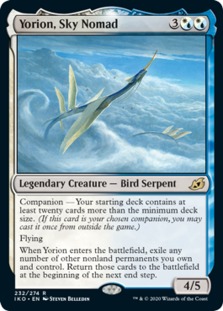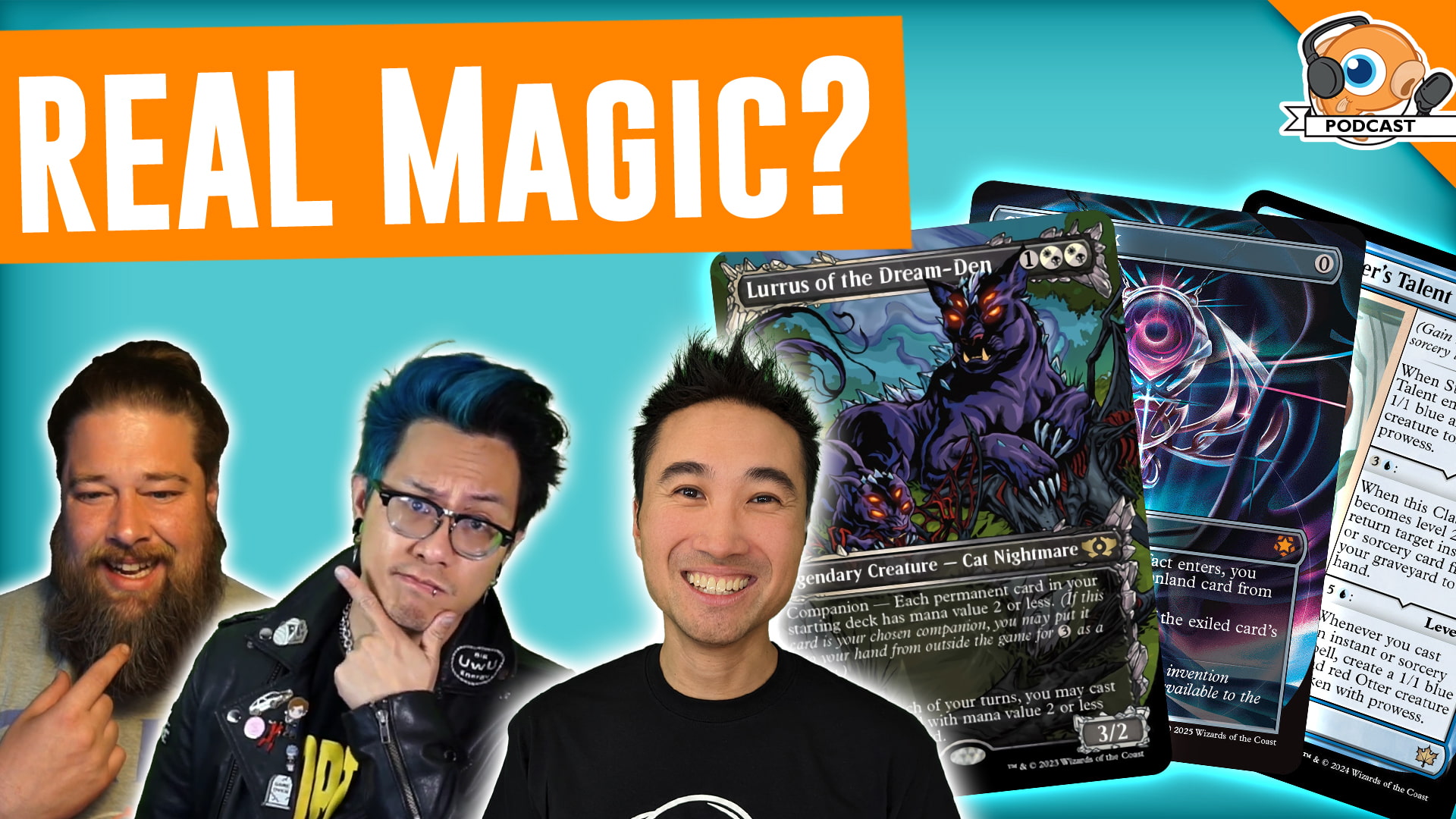Against the Odds: Companion Tribal Fakeout (Standard)
Hello, everyone. Welcome to episode 240 of Against the Odds. Companions are widely considered to be broken and possibly some of the most powerful cards printed since the Power Nine, 27 years ago. Logically, this should mean that the more companions we play, the more broken are deck will be, right? Today, for Against the Odds, we're playing a deck I'm calling Companion Tribal Fakeout in Standard. Our deck meets the restrictions for a massive six companions, and while we can only have one companion per game, we can switch our companion between games. Apart from putting the brokenness of companions to the test, the idea is that by switching our companion between games, we can sideboard in cards that would be illegal with our original companion's restriction, which means our opponent shouldn't be expecting them and we should get some massive blowouts! Can a deck that meets the restrictions of six different companions work in Standard? Is switching companions every game a legitimate strategy? Does more companions equal more broken? Let's get to the video and find out in today's Against the Odds; then, we'll talk more about the deck!
A quick reminder: if you haven't already, make sure to subscribe to the MTGGoldfish YouTube channel.
Against the Odds: Companion Tribal Fakeout

The Deck
Today's deck started with a very simple idea: how many companion restrictions could a single Standard deck meet? Technically, it is possible to meet the restriction of nine companions in a single deck, but whether or not playing an 80-card singleton deck where every card is a sorcery that has an odd converted mana cost and costs more than three mana actually counts as a "deck" remains to be seen (in reality, it's more of a random pile of cards). I thought about playing the nine-companion deck for today's video, but it simply isn't fun or watchable. The gimmick of "we have nine companions" wears off pretty quickly, and the deck just doesn't do anything at all and has essentially zero chance of ever winning a game.
After deciding that nine companions was probably too many, I shifted my focus to building a deck that could meet the restriction of as many companions as possible but could play creatures so something would actually happen during our games (the "cheat" to getting nine companions is that if you play zero creatures, you automatically meet the restriction of Lurrus of the Dream Den, Kaheera, the Orphanguard, and Zirda, the Dawnwaker). The end result is a deck that meets the restrictions of six companions (with three more companions making an appearance in the main deck, even though we can't play them as companions) but gets to play creatures and looks at least a little bit like a Magic deck, rather than a random one-of pile of cards.

Umori, the Collector is our game-one companion since its "all one card type" is the best for enabling the fakeout plan in games two and three. Having Umori as our companion, by definition, means that we are playing just one card type (which our opponent will quickly figure out is creatures after we cast our first spell). This lulls our opponent into a false sense of security since we shouldn't have any instants, sorceries, or planeswalkers. Then, when we go to game two, we can swap Umori, the Collector for another companion that allows us to play non-creature spells and then "get" our opponent with cards like Chandra, Awakened Inferno, Casualties of War, Mystical Dispute, Ritual of Soot, and the like.


Next up on our potential companions list are Yorion, Sky Nomad and Kaheera, the Orphanguard. Yorion, Sky Nomad has perhaps the easiest companion restriction to meet since all we need to do is play an extra 20 cards in our deck. Meanwhile, Kaheera, the Orphanguard limits our creatures to five select types: Cat, Elemental, Nightmare, Dinosaur, and Beast. When we do our companion swap between rounds, Yorion, Sky Nomad is a good choice for controlling matchups, where it can blink cards like Risen Reef and Cloudkin Seer to generate additional card advantage. Meanwhile, Kaheera, the Orphanguard allows us to go aggressive by pumping all of our creatures and is also our cheapest potential companion, making it a good choice against aggro, where having a 3/2 blocker on Turn 3 is relevant.



Rounding out our potential companions are Keruga, the Macrosage (which makes us play only cards that cost three or more), Jegantha, the Wellspring (which keeps us from playing duplicate-mana costs), and Obosh, the Preypiercer (which make us play only odd-converted-mana-cost cards). Keruga is another good companion choice for control, offering immediate card advantage when it comes into play. Jegantha, the Wellspring becomes our companion in games where we want to bring in Kenrith, the Returned King from our sideboard since the extra mana Jegantha produces helps us activate Kenrith. Meanwhile, due to a series of unfortunate events, Obosh, the Preypiercer isn't technically in our deck. (Initially, it was our game-one companion, until I realized that the "all creature" restriction of Umori, the Collector was better for the fakeout plan. Then, when I tried to switch Obosh and Umori, Obosh somehow ended up being left out of the deck altogether, although its restriction is still met by our deck).
Putting this all together, this means our deck is 80 cards, which are all creatures that are Cats, Beasts, Dinosaurs, Nightmares, or Elementals with odd converted mana costs that cost at least three mana and don't have duplicate-mana costs.
Extra Notes
- Initially, I put all of our companions in the sideboard (mostly because the companion you reveal for a specific game needs to be in your sideboard) but quickly realized this was a bad plan. Since all of the companions are creatures, we can play them in our main deck with Umori, the Collector as our game-one companion and then simply sideboard out the companion we want to use for games two and three and reveal it instead of Umori, the Collector. The main benefit of this is that it gives us more room in our sideboard for unexpected "fakeout" cards that we want to bring in with various companions.
- Technically, our main deck doesn't meet the restriction of every companion; instead, it meets Umori's restriction and comes close enough to meeting the rest of our companions' restrictions that we can sideboard out the cards that don't meet the restriction when needed. For example, in games where we play Kaheera, the Orphanguard as our companion, we have to sideboard out Yorion, Sky Nomad since it's the one creature in our deck that isn't one of Kaheera's creature types. If we choose Jegantha, the Wellspring as our companion, we need to take out some of our other companions (Yorion, Sky Nomad, Keruga, the Macrosage, Zirda, the Dawnwaker, Lutri, the Spellchaser, Lurrus of the Dream Den, and Kaheera, the Orphanguard) since they all have duplicate-mana costs. Making sure the deck is legal for whatever companion you want to play is especially important on Magic Arena, where it will simply revert back to your original deck (and not keep any of your sideboarding choices) if you submit a deck that doesn't meet your companion's restriction (we actually did this in our first match, where, like an idiot, I tried to switch to Jegantha, the Wellspring but also bring in the double-black Ritual of Soot).
- As far as the basic theory of which companion to choose in each game, it depends on two things: what deck our opponent is playing and what sideboard cards we want to bring in. Here's a super-quick rundown:
- Yorion, Sky Nomad: Best in slower, grindy matchups; can play it whatever you want.
- Jegantha, the Wellspring: Good against aggro, where we can bring in Heartless Act and Omnath, Locus of the Roil for removal as well as Aether Gust and Kenrith, the Returned King for lifegain.
- Kaheera, the Orphanguard: Good when we want to be aggressive, allows us to bring in all of our sideboard spells, and is also our cheapest companion for blocking on Turn 3.
- Keruga, the Macrosage: Good against control and midrange. Generates immediate card advantage, and allows us to bring in Chandra, Awakened Inferno, Mystical Dispute, and Casualties of War.
- Obosh, the Preypiercer: Good with our main deck in matchups where we want to be aggressive rather than ramp with Umori, the Collector.
The Odds
All in all, we went 2-3 with Companion Tribal Fakeout, which is actually way better than I expected. If someone at your local FNM said that their deck was 80 odd-CMC Elementals, Cats, Dinosaurs, Nightmares, and Beasts that cost at least three mana and don't have any duplicate-mana costs, how many wins would you expect them to get? I'd say zero, but apparently, companions really are so busted that you can meet multiple restrictions in one deck and still win some games! We even got some sweet fakeout wins, especially in our last match, where Mystical Disputes—which our opponent likely assumed weren't legal in our deck thanks to seeing Umori, the Collector in game one—were essential to our win.
While meeting the restrictions for six companions at once is probably a bit too much from a competitive perspective, I do think that playing multiple companions is something competitive decks should experiment with more. For example, Yorion, Sky Nomad and Keruga, the Macrosage have both found success in Fires of Invention shells. What about building 80-card Jeskai Fires with Keruga, the Macrosage as your game-one companion (since it's the best companion in Jeskai Fires) and a Yorion, Sky Nomad in your main deck? This would allow you to switch to Yorion, Sky Nomad as your companion in games two and three against a deck like Mono-Red Aggro and bring in four copies of Aether Gust, which would otherwise be illegal with Keruga, the Macrosage.
So, does playing more broken companions make your deck more broken? The answer is more complicated than I thought it would be when heading into our games. I fully expected the answer to be a firm no, and while meeting the restrictions of too many companions does reduce the power of your deck (by making your card pool very small), I do think that players should explore the possibility of building decks that work with two or maybe three companion restrictions, to not only allow for more diverse sideboarding plans (while still making sure you get to start the game with eight cards rather than losing a companion altogether) but also limit the information advantage your opponent gets from knowing that your companion is keeping you from playing certain cards.
Vote for Next Week's Deck
The Against the Odds poll has moved to YouTube! Click here to vote for next week's deck!
Conclusion
Anyway, that's all for today. As always, leave your thoughts, ideas, opinions, and suggestions in the comments, and you can reach me on Twitter @SaffronOlive or at SaffronOlive@MTGGoldfish.com.













